
Previous Articles 5
Below are selected articles published on this site January - March 2010. We hope you will find some of interest.
Articles here have been moved from our Recent Articles & Announcements page and are in reverse chronological order.
Tuesday 2 March 2010
Field Ambulance

We were asked for information about the Carlton Ware model of a World War One field ambulance shown on the left. What did the WD separated by a vertical upwards pointing arrow painted on the radiator mean?
Carlton Ware Heraldic china, to which this belongs, can offer a fascinating history of the first quarter of the Twentieth Century, when it was produced. The small details found on some of the models can be serendipitous, as in this instance.
Here, WD stands for War Department, but what about the curious glyph between the initials?
Carlton Ware Heraldic china, to which this belongs, can offer a fascinating history of the first quarter of the Twentieth Century, when it was produced. The small details found on some of the models can be serendipitous, as in this instance.
Here, WD stands for War Department, but what about the curious glyph between the initials?

The arrow that separates the letters is a symbol for Government property, probably best known for having been used on convicts clothing. Also called a Pheon, it has been in use since the reign of William & Mary and items marked with it were found on the Tudor ship The Mary Rose, which sank in 1545.
The arrow frequently appeared on military boxes and equipment such as canteens, bayonets and rifles, as well as the British prison uniform from the 1870s, and even earlier on that of transportees in British penal colonies such as Australia.
Today's Ministry of Defence continues to use the mark.
The arrow frequently appeared on military boxes and equipment such as canteens, bayonets and rifles, as well as the British prison uniform from the 1870s, and even earlier on that of transportees in British penal colonies such as Australia.
Today's Ministry of Defence continues to use the mark.

On the left we show what is believed to be the only surviving field ambulance from WW1, once named 'Gutless Gertie' and now in New Zealand.
Initially, cars were donated by individuals for the war effort to be fitted with ambulance bodies. Some wealthy families included their chauffeurs!
The Red Cross symbol used on the Carlton Ware model and on the surviving vehicle needs no explanation. You can see that the ceramic version is quite faithful to what became the Red Cross's standard body for field ambulances. © Harvey Pettit 2010.
We would like to thank Debbie Rhodes of the Wanaka Transport & Toy Museum in New Zealand for permission to use her photograph of 'Gutless Gert! Thanks also to The Cochrane & Pettit Archive of Carlton Ware for the information provided.
We would like to thank Debbie Rhodes of the Wanaka Transport & Toy Museum in New Zealand for permission to use her photograph of 'Gutless Gert! Thanks also to The Cochrane & Pettit Archive of Carlton Ware for the information provided.
Scroll down for more.
Wednesday 17 February 2010
The RUMIDOR
Its secrets revealed....
Its secrets revealed....
Click the left triangular play button on the control panel below to hear some fitting music.
The title is not too difficult to guess, but is given at the end of this article.
The title is not too difficult to guess, but is given at the end of this article.
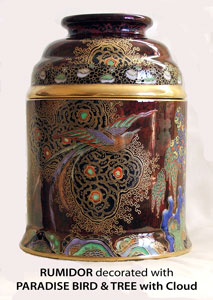


Chris Rutter kindly sent us these pictures of a RUMIDOR decorated with the PARADISE BIRD & TREE with Cloud 3144 pattern. These beg the question, what exactly is a RUMIDOR and what is known of The Rumidor Corporation? As far as we know, nothing has been published on this curiosity, or the company that patented the Rumidor trade mark. However, The Cochrane & Pettit Archive of Carlton Ware was able to throw light on these unusual items and those who were involved with their manufacture. Clearly, we are looking at a type of humidor to keep tobacco, cigars and cigarettes moist, but read on....

The C&P Archive's research led to a copy of the US patent for a humidor on which the Rumidor was based. Filed in 1927, the patent revealed some of the mysteries of the device and the curious metal fittings in its lid. These provided a receptacle for a Rumidor refill, which contained the moistening agent for the tobacco. The picture on the right shows one of these refills, amongst some perforated cigar containers.
The secret of the Rumidor is revealed by the writing on the refill, which tells us that the moistening agent is rum. Hence the name!
Amongst tobacco aficionados, there is some debate as to whether or not rum infusion improved flavour, but clearly it was a excellent piece of marketing on the part of the Rumidor Corporation, whose office was at 501 Fifth Avenue, New York. By 1929 adverts for their products appeared in magazines and newspapers. Below, is one of these from The New Yorker with an image of the magazine's cover for 2 March 1929, the date of the advertisement.
The secret of the Rumidor is revealed by the writing on the refill, which tells us that the moistening agent is rum. Hence the name!
Amongst tobacco aficionados, there is some debate as to whether or not rum infusion improved flavour, but clearly it was a excellent piece of marketing on the part of the Rumidor Corporation, whose office was at 501 Fifth Avenue, New York. By 1929 adverts for their products appeared in magazines and newspapers. Below, is one of these from The New Yorker with an image of the magazine's cover for 2 March 1929, the date of the advertisement.


The Rumidor Corporation's 1929 publicity shows the cylindrical body of a metal Rumidor covered in Alpina lizard skin with what appears to be wickerwork covering the domed lid. This version of the Rumidor and the cigarette case and lighter, also shown in the advert, were made for the American Branch of Benson & Hedges, who by 1928 was independent of British Company. Exotic materials such as lizard, snake, alligator and sharkskin (shagreen) were very fashionable in the Art Deco period (and the reason why Carlton Ware made coffee sets with simulated shagreen decorations).


Most significantly for collectors of Carlton Ware, the advert states that the Rumidor was Sponsored in Europe by Alfred Dunhill, who is famous for high quality tobacco supplies and accoutrements. Someone at Dunhill must have realised that a ceramic Rumidor, like tobacco jars and humidors, would be even more desirable than metal ones. This is part of Dunhill's association with Carlton Ware, as the company had commissioned the pottery to make, not only these unusual receptacles, but also ceramic table lighters and more conventional tobacco jars.


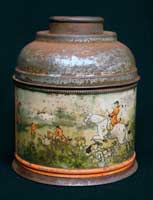
On the right are three more different metal Rumidors, one in hammered copper, one in copper with a leather covering and one made from tin-plate, which has been printed with a hunting scene.

It is worth noting that the Rumidor was devised and introduced during the U.S.A's Prohibition period (1920-1933) when manufacture and sale of alcohol for consumption was banned. Was the introduction of the Rumidor and its rum refills a way around this? Presumably, it would have been legitimate to sell the refills for their intended purpose. However, we do not know if the refills could be decanted of their rum, or whether some form of absorbent material contained the liquor. This is of course a fanciful suggestion, which the advert above probably discounts since it states the use of solidified rum, though quite how rum is 'solidified' is a mystery. In any case, the 12-year-old rum used in the refills would have been easy for The Rumidor Corporation to buy since Prohibition would have produced a glut in the nearby Caribbean, despite the tens of thousands of illegal speakeasy drinking clubs in New York alone. Carlton Ware was never knowingly a boot-legger!

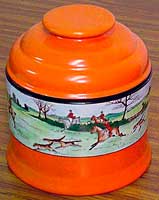
Notice that advertisement from The Cornell Daily Sun shows two sizes of Rumidor; the larger version was designed for cigars and the smaller for cigarettes.
Chris's Carlton Ware example shown at the beginning of this article is the larger version, as is the one on the right decorated with CHINESE BIRD & CLOUD 3274. The picture far right shows the smaller, more squat container. This is decorated with the HUNT SCENES pattern, similar to the decoration on the tin-plated Rumidor above.
Chris's Carlton Ware example shown at the beginning of this article is the larger version, as is the one on the right decorated with CHINESE BIRD & CLOUD 3274. The picture far right shows the smaller, more squat container. This is decorated with the HUNT SCENES pattern, similar to the decoration on the tin-plated Rumidor above.

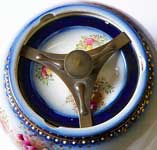
Humidors, or Rumidors, must not be confused with tobacco jars, which do not provide a method of moistening tobacco. Tobacco jars are generally air-tight and often have a rubber seal incorporated into their lids. Sometimes, as on the Carlton Ware Blushware example on the left, decorated with the Heather pattern, the air-tight seal is assured with a rotating metal clamp.
The humidor, on which the Rumidor was based, was invented by Richard D. Zucker. He assigned his 1927 patent to The Rumidor Corporation in 1929. You can view his original US patent with its drawings and description by clicking here. © Harvey Pettit 2010.
The humidor, on which the Rumidor was based, was invented by Richard D. Zucker. He assigned his 1927 patent to The Rumidor Corporation in 1929. You can view his original US patent with its drawings and description by clicking here. © Harvey Pettit 2010.
We would like to thank Chris Rutter for the pictures of his Rumidor and The Cochrane & Pettit Archive of Carlton Ware for its history of the The Rumidor Corporation. Thanks also to Maria Wagner for permission to use her pictures of the Blushware tobacco jar.
The title of the music excerpt is Smoke Gets in Your Eyes composed by Jerome Kern. It was written for the 1933 operetta Roberta. To see Fred Astair & Ginger Rogers performing this number in their 1935 film adaptation click here. Sheer elegance and frock!
The title of the music excerpt is Smoke Gets in Your Eyes composed by Jerome Kern. It was written for the 1933 operetta Roberta. To see Fred Astair & Ginger Rogers performing this number in their 1935 film adaptation click here. Sheer elegance and frock!
Scroll down for more.
Friday 22 January 2010
Marriage Scent to Coventry!



The middle picture above shows what appears to be a Chinoiserie Carlton Ware scent bottle, which appeared for sale on eBay recently and was inevitably described as rare (as is so much on the online auction house!) The decoration is part of the CHINESE FIGURES pattern; the metal cap is silver.
It is a good example of what in the antiques business is called a marriage, where two or more authentic items are combined, usually in an attempt to add value. The bottle vase in the picture on the left shows how the Carlton Ware part of the union looked before truncation.
It is a good example of what in the antiques business is called a marriage, where two or more authentic items are combined, usually in an attempt to add value. The bottle vase in the picture on the left shows how the Carlton Ware part of the union looked before truncation.
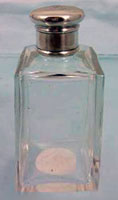
The silver cap is probably taken from a glass scent or cologne bottle of the type shown on the right. At first sight, the marriage is quite convincing. The hall-marked silver top was assayed in Birmingham, not Coventry as our playful headline indicates, and gives a date of 1895, more than thirty years before CHINESE FIGURES was introduced. The picture, above right, shows the hall-mark, as well as indicating that the neck has been cut, evident from the exposed unglazed white body.
Hall-marked silver fittings were used with Carlton Ware, most notably with smoking accessories such as tobacco jars, most of which date from the 1920s and 30s. Usually, these were used to strengthen and decorate rims to lids, as shown on the items below- some are a little tarnished.
Hall-marked silver fittings were used with Carlton Ware, most notably with smoking accessories such as tobacco jars, most of which date from the 1920s and 30s. Usually, these were used to strengthen and decorate rims to lids, as shown on the items below- some are a little tarnished.

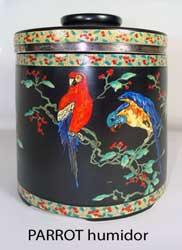
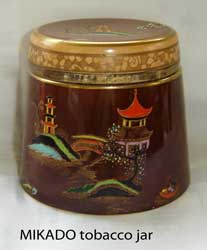 © Harvey Pettit 2010
© Harvey Pettit 2010Images by Harvey Pettit © Copyright 2009. All rights reserved.

